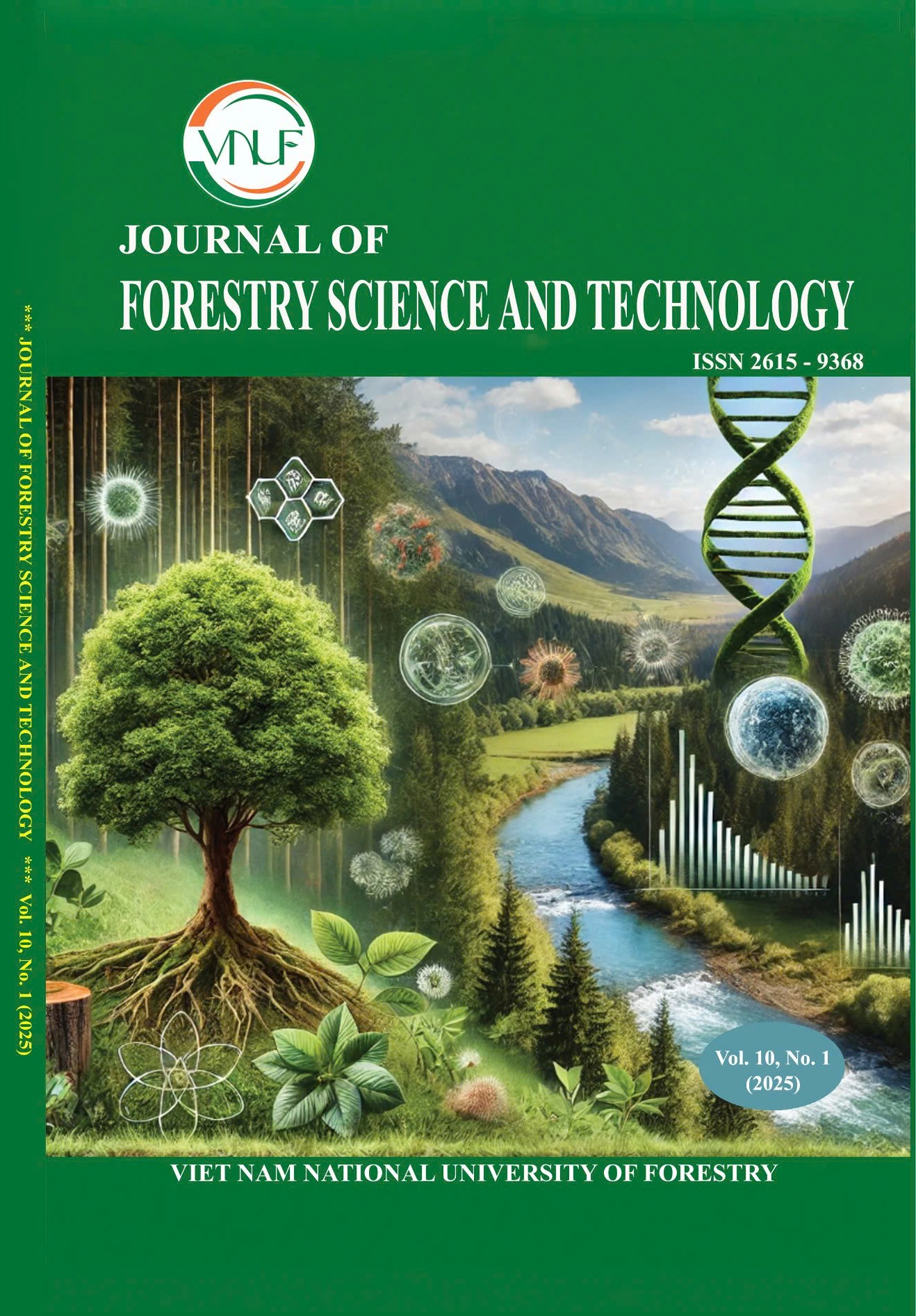Small-scale Spatial Structures of Plant Species: Mechanisms, Implications, and Future Directions
DOI:
https://doi.org/10.55250/Jo.vnuf.10.1.2025.022-032Keywords:
Biodiversity maintenance, community dynamics, dispersal mechanisms, disturbance impacts, plant-plant interactionsAbstract
Small-scale spatial structures of plant communities represent a critical driver of population dynamics, species interactions, and fundamental ecological processes. At localized scales, plants experience biotic and abiotic conditions that often deviate from broader environmental gradients. These conditions are shaped by conspecific and heterospecific neighborhood interactions, which directly influence individual fitness, survival, and regeneration. Small -scale spatial patterns arise from habitat heterogeneity, dispersal limitations, plant-plant facilitation or competition, interactions with biotic agents (e.g., pollinators, herbivores), and stochastic disturbances. Despite their ecological significance, a comprehensive synthesis of the mechanisms driving these spatial structures remains incomplete, hindering their integration into predictive models of community dynamics. This review synthesizes current knowledge to address critical gaps in understanding, focusing on six key determinants of small-scale spatial organization: (1) habitat heterogeneity, (2) plant dispersal mechanisms, (3) intra- and interspecific interactions, (4) biological environment, (5) disturbance regimes, and (6) multifactorial synergies. Additionally, the functional consequences of these spatial patterns are evaluated, particularly their roles in biodiversity maintenance, intraspecific genetic diversity, and ecosystem recovery trajectories. Methodological limitations are critically examined, including scale mismatches in spatial analyses, overreliance on equilibrium assumptions, and insufficient incorporation of plant functional traits. To address these challenges, several research priorities are proposed: (i) integrating small-scale spatial data into macroecological models using hierarchical frameworks, (ii) adopting plant-centric approaches to quantify individual-level interactions, (iii) identifying ecologically relevant spatial scales through gradient analysis, and (iv) employing spatially explicit models (e.g., point-pattern analysis, agent-based simulations) to disentangle stochastic and deterministic drivers. Finally, the translation of insights from small-scale spatial ecology into restoration practices is emphasized, advocating for leveraging pattern-process feedback loops and incorporating spatial heterogeneity into conservation frameworks. This approach aims to bridge the gap between theoretical understanding and practical applications in ecosystem management.
References
. Sta P. (1995). Landscape ecology: spatial heterogeneity in ecological systems. Science. 269(1): 331-334.
. Jiang W., Liu T., Ding L., Wen G., Zhang W. & T. Z. (2003). Progress in spatial heterogeneity research in landscape ecology. Journal of Zhejiang Forestry College. 20(3): 311-314.
. Legendre P. & Fortin M. J. (1989). Spatial pattern and ecological analysis. Vegetatio. 80: 107-138.
. Borcard D., Legendre P., Avois-Jacquet C. & Tuomisto H. (2004). Dissecting the spatial structure of ecological data at multiple scales. Ecology. 85(7): 1826-1832.
. Dale M. R. & Fortin M.-J. (2014). Spatial analysis: a guide for ecologists. ed. Cambridge University Press.
. Zhang L., Hui G., Hu Y. & Zhao Z. (2018). Spatial structural characteristics of forests dominated by Pinus tabulaeformis Carr. Plos one. 13(4): e0194710.
. Bolker B. M., Pacala S. W. & Neuhauser C. (2003). Spatial dynamics in model plant communities: what do we really know? The American Naturalist. 162(2): 135-148.
. Chacón-Labella J., De la Cruz M., Vicuña R., Tapia K. & Escudero A. (2014). Negative density dependence and environmental heterogeneity effects on tree ferns across succession in a tropical montane forest. Perspectives in Plant Ecology, Evolution and Systematics. 16(2): 52-63.
. Stowe L. G. & Wade M. J. (1979). The detection of small-scale patterns in vegetation. The Journal of Ecology. 1047-1064.
. Silander J. A. & Pacala S. W. (1985). Neighborhood predictors of plant performance. Oecologia. 66: 256-263.
. Dieckmann U., Law R. & Metz J. A. (2000). The geometry of ecological interactions: simplifying spatial complexity. ed. Cambridge University Press.
. Purves D. & Law R. (2002). Fine-scale spatial structure in a grassland community: quantifying the plant's-eye view. Journal of Ecology. 121-129.
. Fletcher R. & Fortin M. (2018). Spatial ecology and conservation modeling. ed. Springer.
. Loke L. H. & Chisholm R. A. (2022). Measuring habitat complexity and spatial heterogeneity in ecology. Ecology Letters. 25(10): 2269-2288.
. Kneitel J. M. & Chase J. M. (2004). Trade‐offs in community ecology: linking spatial scales and species coexistence. Ecology letters. 7(1): 69-80.
. Thiery J., d'Herbès J.-M. & Valentin C. (1995). A model simulating the genesis of banded vegetation patterns in Niger. Journal of Ecology. 497-507.
. Shen Z. (2002). A multi-scale study on the vegetation-environment relationship of a mountain forest transect. Acta Ecologica Sinica. 22(4): 461-470.
. Snyder R. E. & Chesson P. (2004). How the spatial scales of dispersal, competition, and environmental heterogeneity interact to affect coexistence. The American Naturalist. 164(5): 633-650.
. Xie J. & Deng Z. (2003). Spatial pattern and size structure of Castanopsis castanopsis population in Wuyun Mountain. Chinese Journal of Ecology. 5: 35.
. Shen Z. & Zhang X. (2000). Spatial pattern analysis and topographical interpretation of species diversity in the forests of Dalaoling in the region of the Three Gorges. Journal of Integrative Plant Biology. 42(6): 620.
. Wang Y., Zhang X., Yang J., Tian J., Song D., Li X. & Zhou S. (2024). Spatial heterogeneity of soil factors enhances intraspecific variation in plant functional traits in a desert ecosystem. Frontiers in Plant Science. 15: 1504238.
. Shaghlan S. M., Saaed M. W. & El-Barasi Y. M. (2023). Does the islands of fertility concept enhance our understanding of rangeland’s degradation and rehabilitation potential in the southern El-Jabal El-Akhdar region, Libya? Libyan Journal of Ecological & EnvironmentalSciences and Technology. 18(1): 122-137.
. Getzin S., Wiegand T., Wiegand K. & He F. (2008). Heterogeneity influences spatial patterns and demographics in forest stands. Journal of Ecology. 96(4): 807-820.
. Silvertown J. & Law R. (1987). Do plants need niches? Some recent developments in plant community ecology. Trends in Ecology & Evolution. 2(1): 24-26.
. Nguyen Van Quy, Kang Yong Xiang, Ashraful Islam, Li Meng, Nguyen Thanh Tuan, Nguyen Van Quy & Nguyen Van Hop (2022). Spatial distribution and association patterns of Hopea pierrei hance and other tree species in the Phu Quoc island evergreen broadleaved forest of Vietnam. Applied Ecology & Environmental Research. 20(2): 1911-1933.
. Fllner S. & Shmida A. (1981). Why are adaptations for long-range seed dispersal rare in desert plants? Oecologia. 51: 133-144.
. Van Oudtshoorn K. V. R. & Van Rooyen M. W. (2013). Dispersal biology of desert plants. ed. Springer Science & Business Media.
. Huang Z., Peng M., Chen G., Shi P. & Zhou G. (2001). The spatial distribution patterns and dynamics of some wetland dominant plants of the Qinghai lake. Journal of Applied and Environmental Biology. 7(2): 113-116.
. Callaway R. M. (2007). Positive interactions and interdependence in plant communities. ed. Springer. 415
. Caldwell M. M., Bornman J., Ballaré C., Flint S. D. & Kulandaivelu G. (2007). Terrestrial ecosystems, increased solar ultraviolet radiation, and interactions with other climate change factors. Photochemical & Photobiological Sciences. 6(3): 252-266.
. Ford E. D. & Sorrensen K. A. (2018). Theory and models of inter-plant competition as a spatial process. Individual-based models and approaches in ecology, Chapman and Hall/CRC. 363-407.
. Huston M. A. (1999). Local processes and regional patterns: appropriate scales for understanding variation in the diversity of plants and animals. Oikos. 393-401.
. Weiner J. (1990). Asymmetric competition in plant populations. Trends in ecology & evolution. 5(11): 360-364.
. Schupp E. W. (1992). The Janzen-Connell model for tropical tree diversity: population implications and the importance of spatial scale. The American Naturalist. 140(3): 526-530.
. Wisz M. S., Pottier J., Kissling W. D., Pellissier L., Lenoir J., Damgaard C. F., Dormann C. F., Forchhammer M. C., Grytnes J. A. & Guisan A. (2013). The role of biotic interactions in shaping distributions and realised assemblages of species: implications for species distribution modelling. Biological reviews. 88(1): 15-30.
. Bromley J., Brouwer J., Barker A., Gaze S. & Valentine C. (1997). The role of surface water redistribution in an area of patterned vegetation in a semi-arid environment, south-west Niger. Journal of Hydrology. 198(1-4): 1-29.
. Chen P., Chu Y., Gu F., Zhang Y. & Pan X. (2003). Spatial heterogeneity of vegetation and soil characteristics in oasis-desert ecotone. Ying Yong Sheng tai xue bao. The Journal of Applied Ecology. 14(6): 904-908.
. Liu Z. & Li Z. (2004). Fine-scale spatial pattern of Artemisia frigida population under different grazing intensities. Acta Ecologica Sinica. 24(2): 227-234.
. Abe S., Masaki T. & Nakashizuka T. (1995). Factors influencing sapling composition in canopy gaps of a temperate deciduous forest. Vegetatio. 120: 21-32.
. Barik S., Pandey H., Tripathi R. & Rao P. (1992). Microenvironmental variability and species diversity in treefall gaps in a sub-tropical broadleaved forest. Vegetatio. 103: 31-40.
. Zhang W., Huang W. & Yang Z. (2003). The study on the relationship between mini-patch and degradation of pasture.
. Nguyen van Quy, Nguyen Van Hop, Pham Mai Phuong & Nguyen Hong Hai (2023). Coexistence mechanisms of tree species in an evergreen forest on Con Dao Islands, Vietnam. Biology Bulletin. 50(4): 717-733.
. Jeltsch F., Milton S. J., Dean W. R. J. & van Rooyen N. (1997). Simulated pattern formation around artificial waterholes in the semi‐arid Kalahari. Journal of Vegetation Science. 8(2): 177-188.
. Xin X. P., Yang Z. Y., Tian X. Z. & Gao Q. (2000). Patch dynamics of alkaline Leymus chinensis grassland under grazed and ungrazed conditions. Chinese Journal of Plant Ecology. 24(6): 656.
. Yang L., Han M., Zhou G. & Wang Y. (2002). Studies on the maintaining mechanism of species diversity of grassland community. Journal of Jilin Agricultural University. 24(1): 58-63.
. Van Baalen M. & Rand D. A. (1998). The unit of selection in viscous populations and the evolution of altruism. Journal of theoretical biology. 193(4): 631-648.
. Bolker B. M. & Pacala S. W. (1999). Spatial moment equations for plant competition: understanding spatial strategies and the advantages of short dispersal. The American Naturalist. 153(6): 575-602.
. Rainey P. B. & Travisano M. (1998). Adaptive radiation in a heterogeneous environment. Nature. 394(6688): 69-72.
. Hamilton W. D. & May R. M. (1977). Dispersal in stable habitats. Nature. 269(5629): 578-581.
. Maurer B. A. (1999). Untangling ecological complexity: the macroscopic perspective. ed. University of Chicago Press.
. Farina A. (2012). Landscape ecology in action. ed. Springer Science & Business Media.









